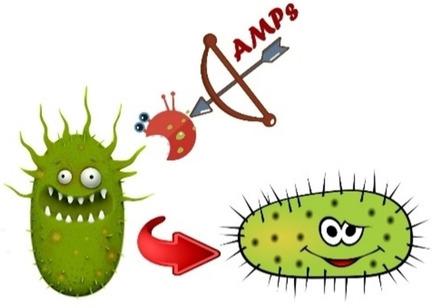当前位置:
X-MOL 学术
›
ChemMedChem
›
论文详情
Our official English website, www.x-mol.net, welcomes your
feedback! (Note: you will need to create a separate account there.)
Cationic Amphiphilic Peptides: Synthetic Antimicrobial Agents Inspired by Nature.
ChemMedChem ( IF 3.6 ) Pub Date : 2020-08-07 , DOI: 10.1002/cmdc.202000301 Rajen Kundu 1, 2
ChemMedChem ( IF 3.6 ) Pub Date : 2020-08-07 , DOI: 10.1002/cmdc.202000301 Rajen Kundu 1, 2
Affiliation

|
Antimicrobial peptides are ubiquitous in multicellular organisms and have served as defense mechanisms for their successful evolution and throughout their life cycle. These peptides are short cationic amphiphilic polypeptides of fewer than 50 amino acids containing either a few disulfide‐linked cysteine residues with a characteristic β‐sheet‐rich structure or linear α‐helical conformations with hydrophilic side chains at one side of the helix and hydrophobic side chains on the other side. Antimicrobial peptides cause bacterial cell lysis either by direct cell‐surface damage via electrostatic interactions between the cationic side chains of the peptide and the negatively charged cell surface, or by indirect modulation of the host defense systems. Electrostatic interactions lead to bacterial cell membrane disruption followed by leakage of cellular components and finally bacterial cell death. Because of their unusual mechanism of cell damage, antimicrobial peptides are effective against drug‐resistant bacteria and may therefore prove more effective than classical antibiotics in certain cases. Currently, around 3000 natural antimicrobial peptides from six kingdoms (bacteria, archaea, protists, fungi, plants, and animals) have been isolated and sequenced. However, only a few of them are under clinical trials and/or in the commercial development stage for the treatment of bacterial infections caused by antibiotic‐resistant bacteria. Moreover, high structural complexity, poor pharmacokinetic properties, and low antibacterial activity of natural antimicrobial peptides hinder their progress in drug development. To overcome these hurdles, researchers have become increasingly interested in modification and nature‐inspired synthetic antimicrobial peptides. This review discusses some of the recent studies reported on antimicrobial peptides.
中文翻译:

阳离子两亲肽:受自然启发的合成抗菌剂。
抗菌肽在多细胞生物中无处不在,并作为其成功进化和整个生命周期的防御机制。这些肽是少于 50 个氨基酸的短阳离子两亲多肽,包含一些具有特征性富含 β-折叠结构的二硫键连接的半胱氨酸残基或线性α-螺旋构象,在螺旋的一侧和疏水侧具有亲水侧链另一边的链条。抗菌肽通过肽的阳离子侧链和带负电荷的细胞表面之间的静电相互作用直接损伤细胞表面,或间接调节宿主防御系统,从而导致细菌细胞裂解。静电相互作用导致细菌细胞膜破裂,随后细胞成分泄漏,最后细菌细胞死亡。由于其不寻常的细胞损伤机制,抗菌肽对耐药细菌有效,因此在某些情况下可能比传统抗生素更有效。目前,来自六大界(细菌、古细菌、原生生物、真菌、植物和动物)的大约 3000 种天然抗菌肽已被分离和测序。然而,其中只有少数处于临床试验和/或商业开发阶段,用于治疗由抗生素耐药菌引起的细菌感染。此外,结构复杂性高,药代动力学特性差,天然抗菌肽的低抗菌活性阻碍了它们在药物开发中的进展。为了克服这些障碍,研究人员对修饰和受自然启发的合成抗菌肽越来越感兴趣。本综述讨论了最近报道的一些关于抗菌肽的研究。
更新日期:2020-08-07
中文翻译:

阳离子两亲肽:受自然启发的合成抗菌剂。
抗菌肽在多细胞生物中无处不在,并作为其成功进化和整个生命周期的防御机制。这些肽是少于 50 个氨基酸的短阳离子两亲多肽,包含一些具有特征性富含 β-折叠结构的二硫键连接的半胱氨酸残基或线性α-螺旋构象,在螺旋的一侧和疏水侧具有亲水侧链另一边的链条。抗菌肽通过肽的阳离子侧链和带负电荷的细胞表面之间的静电相互作用直接损伤细胞表面,或间接调节宿主防御系统,从而导致细菌细胞裂解。静电相互作用导致细菌细胞膜破裂,随后细胞成分泄漏,最后细菌细胞死亡。由于其不寻常的细胞损伤机制,抗菌肽对耐药细菌有效,因此在某些情况下可能比传统抗生素更有效。目前,来自六大界(细菌、古细菌、原生生物、真菌、植物和动物)的大约 3000 种天然抗菌肽已被分离和测序。然而,其中只有少数处于临床试验和/或商业开发阶段,用于治疗由抗生素耐药菌引起的细菌感染。此外,结构复杂性高,药代动力学特性差,天然抗菌肽的低抗菌活性阻碍了它们在药物开发中的进展。为了克服这些障碍,研究人员对修饰和受自然启发的合成抗菌肽越来越感兴趣。本综述讨论了最近报道的一些关于抗菌肽的研究。











































 京公网安备 11010802027423号
京公网安备 11010802027423号